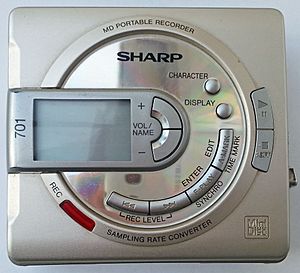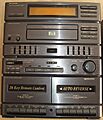Sharp Corporation facts for kids
Logo since 1990
|
|

Headquarters at its factory in Sakai-ku, Sakai, Osaka Prefecture
|
|
|
Native name
|
シャープ株式会社
|
|---|---|
|
Romanized name
|
Shāpu kabushiki gaisha |
|
Formerly
|
Hayakawa Metal Works (1924–1942) Hayakawa Electric Industry Co., Ltd. (1942–1970) Sharp Electric Co. (spin-off) (1956–1967) |
| Public | |
| Traded as | TYO: 6753 Nikkei 225 Component |
| Industry | Consumer electronics |
| Founded | 15 September 1912 Tokyo, Japan |
| Founder | Tokuji Hayakawa |
| Headquarters | Sakai-ku, Sakai, Osaka Prefecture, Japan |
|
Area served
|
Worldwide |
|
Key people
|
Po-Hsuan Wu (president and CEO) Masahiro Okitsu (Executive Vice President) |
| Products | Televisions, audiovisual, home appliances, air conditioner, information equipment, ICs, solar cells, mobile phones, fax machines, electronic components, calculators, LCD panels, personal computers, pumps |
| Revenue | |
|
Operating income
|
|
| Total assets | |
| Total equity | |
| Owners |
|
|
Number of employees
|
46,206 (2023) |
| Subsidiaries | Dynabook Sharp NEC Display Solutions (66.0%) List
Sharp Marketing Japan
Sharp Energy Solutions ScienBiziP Japan Sharp Semiconductor Innovation Sharp Fukuyama Laser Sharp Cocoro Life Sharp Display Technology Sharp Sensing Technology Sharp Electronics Corporation Sharp Electronics of Canada Sharp Corporation Mexico Sharp Electronics (Europe) Limited Sharp International Finance (U.K.) Sharp Electronics (Europe) GmbH Sharp Middle East Free Zone Establishment Sharp Universal Technology (Shenzhen) Shanghai Sharp Electronics Sharp Hong Kong Yantai Xiaye Electronics Sharp (Taiwan) Electronics Sharp Electronics (Malaysia) Sharp Singapore Electronics Sharp Appliances (Thailand) Sharp Manufacturing (Thailand) Sharp Manufacturing Vietnam Sharp Business Systems (India) Sharp Corporation of Australia |
Sharp Corporation (シャープ株式会社, Shāpu Kabushiki-gaisha) is a famous Japanese company. It makes many kinds of electronics. Sharp's main office is in Sakai, Osaka, Japan.
The company was started by Tokuji Hayakawa in 1912 in Honjo, Tokyo. It began as a metal workshop. Later, in 1924, it became the Hayakawa Metal Works Institute in Abeno-ku, Osaka. Since 2016, a company from Taiwan called Foxconn owns most of Sharp.
Sharp has made many different electronic products over the years. These include kitchen items like microwave ovens and refrigerators. They also make home devices like solar cells and vacuum cleaners. For homes and offices, Sharp produces printers, TV sets, calculators, and audio systems.
Contents
Sharp's Story: How It Began
The Early Years (1912–1945)
In 1912, a person named Tokuji Hayakawa opened a small metal workshop in Honjo, Tokyo. His first invention was a special snap buckle called 'Tokubijo'.
Later, in 1915, he invented the "Ever-Ready Sharp" mechanical pencil. This pencil was a huge success around the world. The company even got its name, Sharp, from this popular pencil!
After a big earthquake in 1923 destroyed the pencil business, the company moved to Osaka. There, they started making the first Japanese radio sets. These radios went on sale in 1925. The company officially became "Hayakawa Metal Works" in 1924. In 1942, its name changed to "Hayakawa Electric Industry Company."
Growing Up (1945–1999)

In 1953, Hayakawa Electric started making the first TV sets in Japan. These were called the "Sharp TV3-14T."
A big step happened in 1964 when Sharp made the world's first transistor calculator. It was quite expensive back then. Two years later, in 1966, they made an even more advanced calculator using special electronic parts called ICs.
By 1969, Sharp introduced its first pocket-sized calculator. This one was much more affordable and became very popular. Around the same time, Sharp also created the first microwave oven with a spinning plate inside. In 1970, the company officially changed its name to Sharp Corporation.
Sharp made the first LCD (liquid crystal display) calculator in 1973. Sharp also worked with Nintendo in the 1980s. They made special TV sets that had Nintendo game systems built right in! These are now rare collector's items.
In the 1970s and 1980s, Sharp also made 8-bit home computers. These included the Sharp MZ and Sharp X1 series. They even made a powerful gaming computer called the X68000. Sharp also created small "Pocket Computers" that could be programmed.
Sharp made microwave ovens more affordable for homes in the late 1970s. They were known for making good quality and affordable electronics. In 1992, Sharp introduced the first TV that could be hung on a wall.
The Modern Era (2000–Present)
Sharp's Mobile Communications Division made the world's first commercial camera phone in Japan in 2000.
From 2005 to 2010, Sharp was the biggest mobile phone brand in Japan. In 2007, Sharp introduced a huge prototype LCD TV that was 108 inches big! They later started making this model for sale.
In 2012, Sharp showed off the largest TV available at the time, an 80-inch screen. It was part of their Aquos TV line.
The year 2012 was Sharp's 100th anniversary. However, the company faced some financial challenges. In March 2012, a company called Foxconn agreed to invest in Sharp. They also planned to buy many LCD screens from Sharp's factory in Japan.
In 2013, Sharp created the most efficient solar cell ever. It could turn a record 44.4% of sunlight into electricity. Sharp was also one of the top TV makers in the world.
In 2015, Sharp sold its TV factory in Mexico to another company, Hisense. This meant Sharp stopped selling TVs in North and South America (except Brazil) for a while. However, Sharp remained a top TV brand in Japan.
In October 2015, Sharp announced a smartphone that could also act like a robot, called RoboHon. They also started selling the world's first TV with amazing 8K resolution. This huge 85-inch TV cost a lot of money!
In February 2016, Foxconn announced they would buy a large part of Sharp. This deal was completed in March 2016. Foxconn wanted to sell products directly to customers, not just make parts for other companies.
In March 2017, Sharp's old headquarters building was taken down. By April 2017, Sharp started making a profit again, thanks to changes made by Foxconn. In 2019, Sharp got back the rights to use its own brand name for TVs in the US market.
In March 2020, during the COVID-19 pandemic, Sharp used one of its TV factories to make surgical masks. In August 2020, Sharp fully bought Dynabook, a company that makes computers.
What Sharp Makes
Sharp makes many different kinds of products. Some of their main items include:
- LCD panels (the screens for TVs and phones)
- Solar panels
- Mobile phones
- Audio and video equipment
- Video projectors
- Printers and copiers
- Microwave ovens and air conditioners
- Air purifiers
- Cash registers and calculators
- Special sensors for cameras
Sharp also made the first commercial camera phone in Japan in 2000. Other well-known products include the ViewCam and the AQUOS flat-screen televisions.
For businesses, Sharp makes projectors, monitors, and different kinds of photocopiers. They also create electronic cash registers and point-of-sale systems.
Sharp Solar is a big supplier of photovoltaic (PV) solar cells. They even offered a solar TV! Sharp was a top company for solar PV systems in 2010.
Where Sharp Works
Sharp in Japan

Sharp has many employees, with about half of them working outside Japan. The company has offices and factories in 30 countries. Its products are sold in 164 countries worldwide.
Sharp's main headquarters are in Sakai, Japan. Before 2016, their headquarters were in Abeno-ku, Osaka, where the company first restarted its business in the 1920s.
Sharp in Europe
In 2007, Sharp opened a factory in Poland to make LCD screens. Later, in 2014, a Slovakian company called UMC took over Sharp's TV and audio business in Europe. UMC also bought Sharp's factory in Poland.
Sharp also partnered with Vestel in Europe for home appliances like refrigerators and microwave ovens. Sharp still focuses on business-to-business products in Europe, like printers and energy services. In 2017, Sharp bought a majority share in Skytec UMC, which included the Polish factory.
Sharp Factories Around the World
- Poland: Sharp Manufacturing Poland Sp. z o.o. in Toruń.
- Indonesia: A factory in Karawang that makes refrigerators, started in 2014.
- Malaysia: A TV factory in Shah Alam that makes TVs for export to North America. They also have plants in Batu Pahat (for TVs and Blu-Ray players) and Sungai Petani (for radios and kitchen appliances).
Sharp's Sponsorships
Sharp has sponsored many sports teams over the years.
- Manchester United Football Club: Sharp was the main sponsor for this famous English football team from 1983 to 2000. Their logo was on the team's shirts for 17 years! During this time, the team won many important titles.
- Red Star Belgrade: Sharp also sponsored this football club from 2002 to 2004.
- Hamburger SV: From 1987 to 1994, Sharp was the main shirt sponsor for this German football team.
- Inverness Caledonian Thistle F.C.: Sharp sponsored this Scottish football club from 2001 to 2003.
- Garmin–Sharp: In 2012, Sharp became the name sponsor for a professional cycling team.
- Stoke City F.C.: In 2016, Sharp partnered with this football club for two years.
- Formula Ethara team 'Jack-O-Racers': In July 2024, Sharp sponsored this team for a competition.
Product Gallery
-
Sharp EL-546R scientific calculator
-
Sharp TV/VCR combo
-
Sharp IC I5352SA
Sharp's Slogans
Here are some of the catchy phrases Sharp has used over the years:
- "New Life Now" (Japan only, 1970s–1985)
- "From Sharp Minds Come Sharp Products" (1980s)
- "Be Sharp" (2002–2016)
- "Be Original" (2016–present)
See also
 In Spanish: Sharp Corporation para niños
In Spanish: Sharp Corporation para niños















